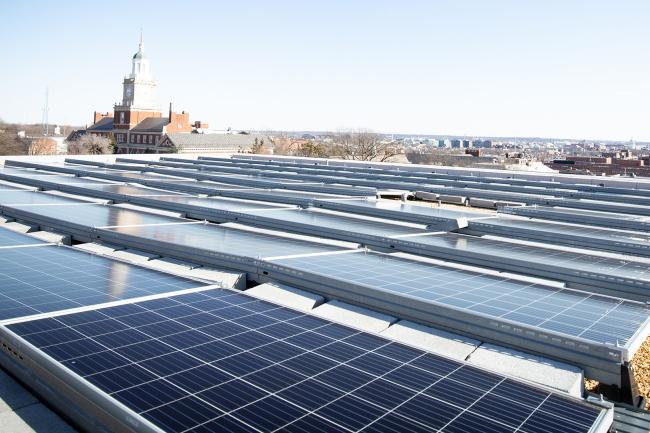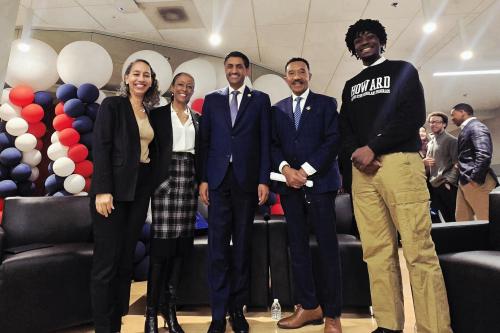While Howard students often leave imprints of their years for future students to follow, one mark Howard does not want them to leave is their carbon footprint.
For the past decade, Howard has been ramping up its on-campus sustainability efforts, both large and small. In the beginning, the University had some serious catching up to do.
“When we first got serious about sustainability some 10 years ago, I would say that the University was behind universities like American, George Washington and Georgetown who already had established Offices of Sustainability,” says Alfonzye “Chip” Chisholm, AIA, LEED AP, director of capital planning for Howard. “However, we quickly started getting involved in the local sustainability scene, including working with the Consortium of Universities.” That helped Howard collaborate with the local universities, District of Columbia government and other organizations to identify sustainability opportunities and needs at Howard.
Funding these projects and initiatives, however, was an issue at Howard, as with most HBCUs. However, Chisholm says the University was able to take advantage of grant and rebate opportunities to kick-start some of the initiatives, such as lighting retrofits. With almost $3 million dollars in grants, rebates and with substantial University investment, Howard now competes on a level field with others in Washington, D.C.
Sustainability Goals
Along with several projects and initiatives, Chisholm says the University has several goals:
- Re-establish the Sustainability Council. To reach across silos, the council will allow for sustainability direction and decision-making to be more inclusive.
- Decrease grid energy dependency. Procure off-campus solar, wind and hydro-electric projects. On-campus solar will provide only a small percent of the University usage demand.
- Complete a Sustainability Strategic Plan. Currently in the procurement/planning stage, this plan will document past achievements and establish a baseline against which to plan the future.
Projects
Several projects are underway or on their way around campus.
Steam plant
Howard recently signed an agreement with ENGIE North America to design and construct a new central utility plant that ENGIE will operate and maintains for the next 20 years. This new steam plant is a combined heat and power plant, generating 35-40 percent of the University’s electric consumption on-site.
Designed to reduce the campus’ carbon footprint and further Howard’s energy efficiency goals, the plant produces a single source of energy that generates electricity or power at the point of use and recycles exhaust heat, which is normally lost in the generation process, to produce steam.
The new plant replaces the aging energy distribution infrastructure on campus. The goal was to develop a cost-effective energy solution to ensure safe operations and eliminate the risk of future campus closures stemming from problems with campus utilities.
Solar panels
Look up at some of Howard’s rooftops and maybe you’ll catch a glimpse of the rows of shiny new solar panels that were recently installed in the Fall of 2020.
Howard worked with Volt Energy, a minority-owned renewal energy firm co-founded and run by Howard alumni, Gilbert Campbell (B.B.A. ’01) and S. Antonio Francis (B.S. ’01), to install 1.2 megawatts of solar photovoltaic. Panels were placed on the administration building, service center and law school. It is the largest on-site solar project in Washington, D.C.
The entire project will produce more than 30,000 megawatts of electricity during its 20-year contract, roughly equivalent to the amount of electricity consumed by 3,113 U.S. homes a year. It is Chisholm’s dream to have more projects off-campus so Howard can be even more dependent on the energy generated from the panels as there are only so many rooftops on campus that can house solar panels.
Stormwater management
Stormwater runoff is often a source of water pollution as it enters streams and the District’s storm drain system. The stormwater runoff that comes from the law school parking lot has been an ongoing source of concern for the University and surrounding ecosystem.
To counter the runoff, HU implemented a number of stormwater management efforts, using green infrastructure practices to reduce the runoff. The practices range in structural, vegetative or managerial approaches that can treat or prevent water pollution, such as using bioretention and previous pavers in the parking lot and native plantings in the adjacent lawn and open space. The practices are designed to reduce erosion and pollutants and improve the local ecosystem quality.
Submetering and building energy use
Just how much energy does our campus use on a day-to-day basis? It’s difficult to tell if it’s not being measured. In an effort to grasp a picture of HU’s energy use, the University partnered with GB Energie to install submeters in buildings across campus, using Leviton meters to monitor electricity, gas, water and steam. The data provided from these submeters identify system inefficiencies and equipment problems, which can result in significant savings. In addition, the meters can compare buildings and their energy use against each other. Data is available in 15-minute intervals to build analysis and reports.
LED lighting conversion and sensors
To continue brightening the campus at night while reducing electricity use, Howard also partnered with GB Energie to retrofit all exterior lighting with LED technology. The result was a 50 percent reduction in electricity use. The University is now focusing on retrofitting all interior lights with LED lighting as well and adding lighting sensors in rooms, so that the lights automatically turn off when no one is occupying a room.
“We are among only a few universities that can boast of having 100 percent energy-efficient LED lighting,” Chisholm says proudly. “This resulted in significant carbon footprint and cost reductions. Security and lighting requirements have also both benefitted.”
Student Involvement
The students, of course, have been more than vocal over making Howard more sustainable. “They use the campus and the city as incubators for how major problems can be addressed on a larger scale,” says Tashni-Ann Dubroy, Ph.D., executive vice president and chief operating officer at Howard.
For example, she says, through the Home Depot Retool Your School program, students helped build a sustainable garden behind one of the residence halls. They hold campus cleanups and worked with the food service vendor to incorporate environmentally-friendly dining ware.
Students in the College of Medicine and the College of Nursing and Allied Health developed nutrition programs across the city that serve underserved populations. Students in the School of Education conducted studies in economic and utility use, storm water management, and community food and water distribution. They also provided access to public health resources.
Through these efforts, Howard has come a long way in the past decade. Howard is now above the median baseline, according to the DC Building Energy Performance Standard (BEPS) Assessment. With these new projects and initiatives underway, Howard should be moving forward quickly – without a trace left behind.





